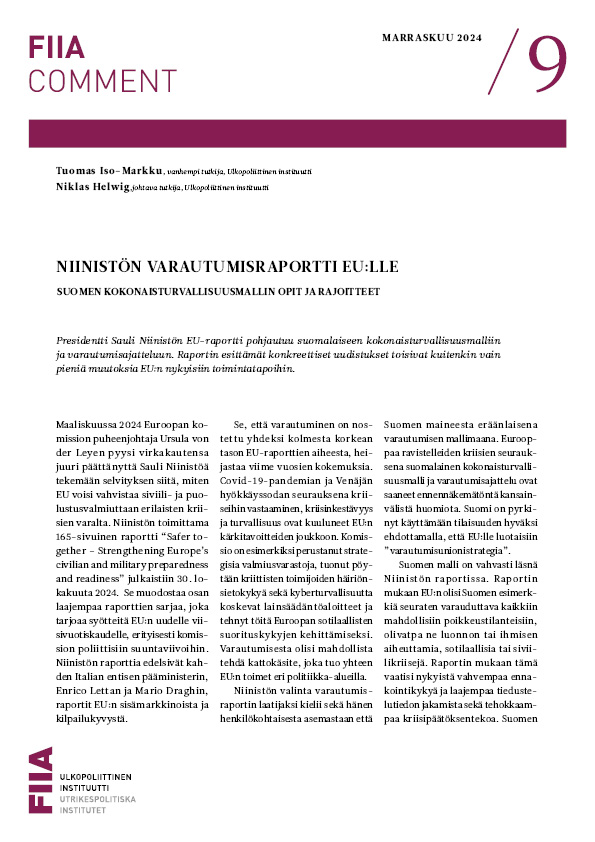
The high-level report by former Finnish President Sauli Niinistö builds on the Finnish model of comprehensive security and national preparedness. However, the measures it proposes would result in only minor adjustments to the EU’s current way of working.
In March 2024, European Commission President Ursula von der Leyen tasked former Finnish President Sauli Niinistö with developing a comprehensive assessment of how the EU could enhance its civilian and military preparedness in the face of different crises. Released on 30 October 2024, the resulting 165-page report, “Safer together – Strengthening Europe’s civilian and military preparedness and readiness”, forms part of a series of inputs aimed at preparing the EU’s new institutional cycle and the Commission’s own political guidelines. It follows reports by two former Italian prime ministers: Enrico Letta’s analysis of deepening the EU’s single market and Mario Draghi’s study on strengthening the Union’s competitiveness.
Including preparedness as one of the three topics addressed in the high-level reports reflects the experiences of recent years. Following the Covid-19 pandemic and Russia’s full-scale invasion of Ukraine, crisis response, resilience and security have featured prominently on the EU’s agenda. The Commission has set up strategic stockpiles, put forward new legislation on the resilience of critical entities and on cyber security, and has sought to bolster European defence capabilities. Preparedness now has the potential to become a new umbrella concept linking the EU’s efforts across different policy fields.
The selection of Niinistö to oversee the report is an acknowledgement of both his personal standing and Finland’s reputation as a “prepper nation”. Against the backdrop of recent emergencies, Finland’s long-standing model of comprehensive security and national preparedness has received unprecedented international attention. The country has embraced the opportunity and advocated an “EU Strategy for a Preparedness Union”.
The Finnish model is clearly visible in the Niinistö report. It argues that the EU should follow Finland’s example in adopting an “all-hazards and all-risks” approach to preparedness, getting ready for all kinds of threats, be they natural or human-caused, civilian or military. According to the report, this would require more extensive foresight capacities and intelligence sharing at the EU level, as well as adequate decision-making mechanisms for crisis situations. Echoing the Finnish tradition, the report also underlines that preparedness is not the responsibility of government authorities alone. Instead, it should be pursued in close cooperation with the private sector, which often plays a crucial role in upholding vital functions of society. Moreover, preparedness should closely involve ordinary citizens.
However, the EU is not Finland. Most Finnish interlocutors would readily admit that the Finnish preparedness model is the result of Finland’s idiosyncrasies: its experiences of war, its harsh climate and geographical isolation, as well as its small, relatively egalitarian society with a high level of trust in public institutions. The EU, by contrast, lacks a shared strategic culture, and its competences vary across different policy fields. Correspondingly, the case for reorganising the EU’s efforts around the concept of preparedness would have been stronger if the Niinistö report had further explored which aspects of the Finnish model might prove most effective within the EU’s complex political system, and could best leverage the Union’s distinctive strengths. For example, although the participation of citizens in preparedness measures is important, the EU – often considered distant and lacking effective communication tools – is hardly the most suitable framework for engaging them.
Overall, the Niinistö report is both broad and thorough. However, the measures it proposes would primarily introduce only minor adjustments to the EU’s current way of working. Across nine thematic blocs, the report presents an exhaustive list of recommendations – such as enhancing EU-NATO cooperation, strengthening the Commission’s Emergency Response Coordination Centre, and rationalising the European defence market – many of which the EU institutions have already been working on.
Niinistö’s caution is most likely intentional: preparedness touches on many issues at the heart of national sovereignty, which means that far-reaching initiatives could quickly be shot down by member states. However, reports such as this one are precisely about presenting ambitious visions that can provide strategic guidance for the EU, even if all the related ideas are not immediately achievable. The circumspect approach is also somewhat out of sync with the situational analysis that informs the report, which paints a grim – but highly credible – picture of the threat scenarios facing the EU, ranging from Russian military aggression to multifaceted emergencies driven by climate change.
The report’s limitations notwithstanding, the EU and its member states would do well to take its general line of argumentation seriously. There are several areas where the EU can provide added value to member states’ preparedness efforts through its economic and diplomatic weight, financial resources, as well as administrative and regulatory capacity. In this vein, the Niinistö report argues that at least 20% of the EU’s overall budget should be spent on security and preparedness, although it stops short of specifying how the costs of urgent security needs should be funded.
Ultimately, building preparedness at the European level will demand more than the level-headed arguments that the Niinistö report provides. It requires the political will of the member states to prioritise security over other objectives, and to look beyond sovereignty and fiscal concerns in doing so. The Commission now has a pivotal role in advocating ambitious solutions that can translate the current crisis-induced political momentum – possibly amplified by Donald Trump’s electoral victory in the US – into tangible outcomes for EU security and preparedness.
















